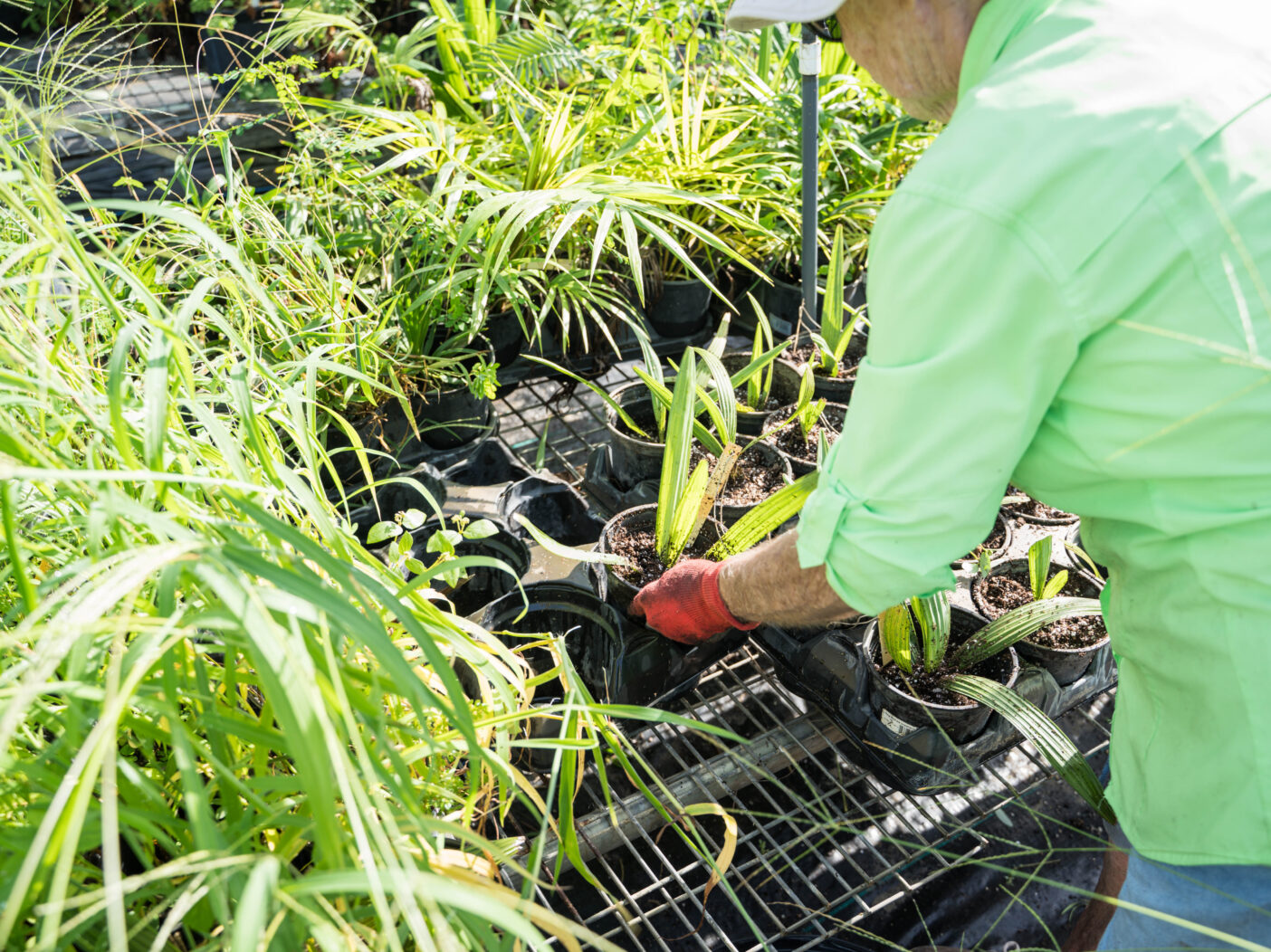
The plants know that something has changed at Naples Botanical Garden. Little weeds grow bigger. Spent flowers wither on their stems. Vines climb up signs.
What is missing in the landscape? It’s the army of horticulture volunteers who normally trim, rake, and otherwise spruce up every corner of the Garden. Health concerns surrounding coronavirus led to the temporary closure of Naples Botanical Garden on March 16, meaning that the 100-plus volunteers who normally serve the Horticulture Department had to suspend their duties.
However, the Garden’s plants continue to grow. The 25 horticulture employees were cleared to return to outdoor work on March 30 and began tending their gardens with new precautionary measures, working physically alone and never sharing tools. Each gardener now faces the daunting task of managing the appearance of his or her garden without the many helping hands of volunteers.

One of the gardeners accustomed to working with lots of volunteers is Andee Naccarato, the Horticulture Volunteer Coordinator & Gardener. She normally starts her day seeing the smiling faces of 5 to 10 volunteers eager to work in the gardens. Now, Andee might work for hours without seeing another person.
The volunteers aren’t far from her mind, however. She thinks about various individuals when she encounters plants they’ve tended.
“Being among all the new wildflowers in the Florida Garden definitely reminds me of the volunteers who planted all those flowers,” Andee says. “Also, some volunteers like to specialize in maintaining specific plants, like bromeliads or bamboo, and I can’t help but think of them when I see those plants.”
She adds, “Besides the tremendous amount of work the volunteers accomplish, I really miss catching up with everyone. I’m used to hearing their funny stories or words of wisdom while we pull weeds or dig holes for new plants. Now that I’m working alone, I’ve started talking to myself (and to butterflies) a lot more!”
The topic of weed control comes up repeatedly in the volunteers’ absence. Gardener Katie Vance admits, “I only fill one or two buckets of weeds a day, which is something our volunteers can accomplish in minutes!”
The cultivated gardens aren’t the only spots where the weeds have sprouted. Andrea Grace, who manages the Garden’s plant nursery, reports, “When I returned to the nursery after two weeks of only watering, the weeds were out of control. I spent a whole week weeding from 7am – 12pm and have only managed to make it through half of the nursery! When I have my volunteers, we finish the whole nursery in less than a week. They are greatly missed!”
In the orchid greenhouse, Director of Collections Nick Ewy usually has several sets of extra hands.
“I certainly miss the assistance in the orchid house with weeding, organizing, and maintenance,” Nick says. “Weeds are growing quickly, and the house is filling up fast with orchids that were previously on display. For the orchids still in the Garden, I miss the volunteers’ help with watering and detailing.”
Trying to maintain a living plant collection without help means the horticulture staff has had to shift some priorities. Aquatic Areas Manager Danny Cox says, “During busy season, we normally have five to eight volunteers who help in the water gardens on a weekly basis and make everything look great. Now, Matt Herrman (Aquatic Areas Technician) and I are trying to complete the tasks the volunteers would typically do, plus manage the mechanical and chemical aspects of running the water features. We have to prioritize controlling the spreading aquatic plants, like lotus and floating fern, and don’t have much time for other tasks, like fertilizing waterlilies.”
While the gardeners battle weeds and ensure plant collections are thriving, Curator of Records Sandra Rigotti-Santos is grateful for all the work her volunteers completed prior to closure.
“Because of everything my volunteers already did to inventory, label, photograph, and log plant coordinates, I now have time to catch up and utilize all the information they compiled. For example, volunteers had previously taken GPS points for trees in a few large sections of the Garden, and now I can view these plants on a map in our database.”

Horticulture staff members agree that the volunteers bring more than just hands to pull weeds or label plants. Their individual personalities, jokes, and stories make every gardening project much more fun. And the younger employees truly look up to the older adults who come in to help. “As much as I miss having the volunteers there to help with day-to-day tasks, I really miss the people themselves,” Danny says. “Many of them have become close friends and mentors to me.”
In this unusual time of social distancing, Katie points out, “It’s a good reminder just how much we are able to accomplish with volunteers’ help.”
Until Naples Botanical Garden can reopen, the horticulture staff will do their best to keep the gardens vibrant and healthy. And volunteers? Don’t worry. There will still be plenty of trimming, raking, and weeding to do when you return. Your Garden friends can’t wait to see you again!
Thank you to the Garden’s horticulture team for sharing these accounts and writing this post in honor of our volunteers.

